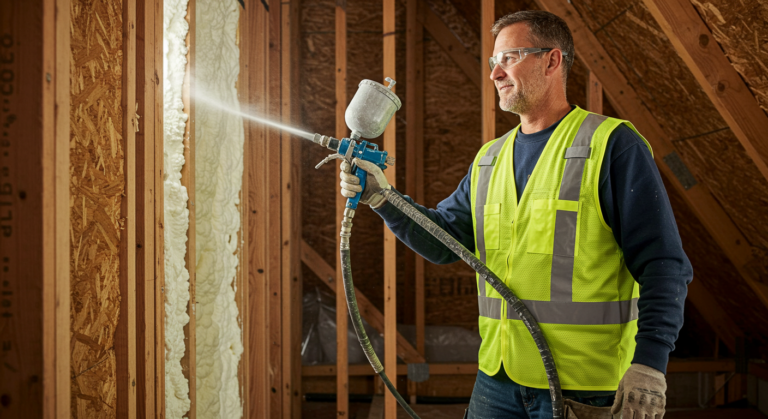Table Of Contents
The Importance of Indoor Air Quality in Green Building Projects for a Healthier Environment
Key Takeaways
- Comprehending indoor environmental conditions is essential for health.
- The consequences of air contamination can adversely affect occupants’ well-being.
- Maintaining air quality within structures is crucial for overall project success.
- The role of indoor environmental conditions is vital in sustainable construction initiatives.
- Techniques for enhancing indoor environmental conditions are necessary for better living spaces.
Understanding Indoor Air Quality
Indoor air quality (IAQ) is a crucial aspect of creating healthy living and working environments. The significance of indoor air quality in green building projects cannot be overstated, as it directly influences the overall indoor environmental quality (IEQ) and the well-being of occupants. High levels of indoor air pollution (IAP) can stem from various sources, including volatile organic compounds emitted from building materials and inadequate ventilation. Ensuring clean indoor air is essential for reducing health risks associated with polluted indoor air, thus promoting comfort and productivity. Green building initiatives often emphasize the importance of effective air quality measures to mitigate outdoor and indoor air pollution, as well as to meet stringent green building certification standards. Prioritizing good indoor air not only enhances occupant health but also contributes to sustainable practices in construction and design.
Definition of Indoor Air Quality
Indoor air quality refers to the condition of the air within indoor environments, significantly impacting occupant health and comfort. Poor air quality can stem from various indoor air pollutants such as volatile organic compounds (VOCs), mold, and particulate matter. Effective air quality monitoring is crucial for assessing the levels of these pollutants, especially in green buildings where the Importance of Indoor Air Quality in Green Building Projects is emphasized. Ventilation systems, including heating ventilation and air conditioning (HVAC), play a vital role in maintaining clean air and preventing household air pollution.
The significance of indoor air quality extends beyond individual well-being; it is a critical component in green construction guidelines established by organizations like the World Green Building Council. These guidelines advocate for the design of buildings that enhance indoor air quality while reducing air pollution. Effective strategies to ensure good indoor air include using low-emission materials and implementing advanced air quality monitoring systems. Such practices not only contribute to healthier indoor environments but also align with broader sustainability goals in the realm of green building.
Factors Affecting Indoor Air Quality
Indoor air quality is significantly influenced by various factors including the design and materials used in a building. The implementation of green walls and green roofs contributes to cleaner air by filtering pollutants and enhancing air quality. The choice of air conditioning units plays a pivotal role; those designed with higher efficiency and better filtration systems can improve indoor environments. Sustainable buildings often integrate these elements, aligning with the well building standard that emphasizes the importance of indoor air quality in green building projects.
Ventilation is essential for maintaining optimal indoor air quality, especially in spaces that are tightly sealed to increase energy efficiency. Effective ventilation systems help mitigate outdoor air pollution and regulate indoor pollutants. The whole building design guide encourages the integration of green technology to create greener buildings that prioritize air quality. By addressing both the architectural and mechanical aspects of a structure, designers can foster environments that contribute to the overall health and well-being of occupants.
- Proper ventilation reduces the buildup of indoor pollutants.
- Use of low-VOC (volatile organic compounds) materials aids in minimizing harmful emissions.
- Regular maintenance of HVAC systems ensures efficient air filtration and circulation.
- Incorporating houseplants can naturally improve indoor air quality by filtering toxins.
- Utilizing air purifiers can help remove airborne pollutants and allergens.
- Limiting moisture through dehumidifiers can prevent mold and mildew growth.
- Implementing a no-smoking policy indoors contributes to healthier air for all occupants.
The Impact of Indoor Air Pollution
Indoor air pollution significantly impacts the health and well-being of occupants, underscoring the importance of indoor air quality in green building projects. Effective ventilation systems, including mechanical ventilation and HVAC equipment, play a crucial role in ensuring clean air circulation and reducing harmful air particulates indoors. The choice of building materials can either enhance or hinder indoor air quality, making their selection vital for creating spaces that promote excellent indoor air. Air quality monitors are crucial in creating green buildings, allowing for real-time assessment of air conditions and ensuring adherence to building standards. Focusing on achieving good indoor air contributes not only to healthier living environments but also highlights the importance of indoor air quality in green building projects, ultimately leading to sustainable and eco-friendly construction practices.
Common Sources of Indoor Air Pollution
Indoor air problems often arise from various sources, significantly impacting the quality of indoor air. Common culprits include volatile organic compounds (VOCs) emitted from paints, cleaning supplies, and furniture. These substances can contribute to poor indoor air, making it essential to monitor and manage them effectively. The importance of indoor air quality in green building projects cannot be overstated, as these initiatives aim to create healthy indoor environments. By employing green building practices, developers can promote indoor air that is optimal for human health, productivity, and wellness.
Another significant source of indoor air pollution comes from inadequate ventilation systems and the use of building materials that release harmful toxins. Similar indoor air quality issues can arise from mold growth, dust mites, and pet dander. Safeguarding indoor air requires understanding the complex air quality dynamics within a building. Ensuring consistent indoor air quality (IAQ) is vital to avoid health complications associated with poor indoor air. By focusing on the importance of indoor air quality in green building projects, stakeholders can better address these sources and contribute to a healthier living space.
Health Implications of Poor Indoor Air Quality
Poor indoor air quality can severely affect physical health, leading to a range of respiratory issues and other ailments. Green buildings work towards enhancing indoor environments by incorporating effective air quality management techniques. The importance of indoor air quality in green building projects becomes evident, as improved air quality contributes to the overall health and well-being of occupants. When green building standards and certifications are followed, the result is not just aesthetically pleasing architecture but also crisp indoor air that supports a healthier lifestyle.
Choosing sustainable building materials can lead to a healthier indoor environment, minimizing toxic emissions that compromise air quality. Green buildings incorporate strategies that promote good air quality, such as proper ventilation and the use of low-emission products. These practices ensure that indoor air needs are met year-round, contributing to a significant indoor advantage. Meeting annual air quality assessments further solidifies the commitment to creating spaces that prioritize the health of occupants and the environment alike.
- Poor indoor air quality can lead to respiratory diseases such as asthma and chronic bronchitis.
- It can exacerbate existing health conditions, making management more difficult for those with allergies or respiratory issues.
- Long-term exposure to pollutants can result in reduced lung function and development of chronic health problems.
- Children and elderly individuals are particularly vulnerable to the effects of poor indoor air quality.
- Improved air quality can enhance productivity and cognitive function in both residential and commercial settings.
- Implementing indoor plants can serve as a natural way to improve air quality and overall well-being.
- Regular maintenance of HVAC systems is crucial for ensuring optimal air quality in indoor environments.
Building Air Quality and Its Significance
The significance of air quality in buildings cannot be understated as it directly influences the health and well-being of occupants. Green buildings aim to create safer indoor environments by utilizing high-quality building materials and green housekeeping products that minimize harmful emissions. The importance of Indoor Air Quality in Green Building Projects is emphasized through adherence to green building guidelines, which promote optimal air quality and the use of air quality monitors. As outdoor air quality can greatly affect indoor environments, implementing strategies that enhance greener buildings’ air helps to ensure a healthy indoor environment. A proactive approach in these projects leads to an overall improvement in air quality, contributing to more sustainable living spaces.
Role of Ventilation in Building Air Quality
Effective ventilation plays a crucial role in maintaining the importance of indoor air quality in green building projects. Properly designed air distribution systems ensure that air quality monitors can provide accurate air quality data. Utilizing air panels improves the flow of fresh air, significantly impacting indoor temperatures and overall comfort. Incorporating indoor plants can further enhance air quality, helping to filter out pollutants and improve the aesthetic of a well-cleaned building. Air-conditioning engineers must be aware of these factors to create sustainable building practices that yield clean and healthy environments.
Ventilation also impacts the selection of building materials, particularly sustainable and low-emission options. High-quality materials work in tandem with ventilation systems to maintain quality indoors. Poor quality buildings often lack adequate ventilation, leading to stagnant air and increased pollutants. Regular maintenance of building equipment is essential to ensure that all components function correctly, supporting the efforts to achieve optimal indoor air quality. Emphasizing ventilation in design not only enhances comfort but also reinforces the overall importance of indoor air quality in green building projects.
How Building Materials Influence Air Quality
Building materials play a crucial role in determining the overall indoor air quality of a structure. The selection of eco-friendly building products can significantly reduce harmful emissions and contribute to a healthier environment. Structures designed with the importance of indoor air quality in green building projects in mind often utilize low-VOC materials. These materials, along with smart ventilation strategies, ensure the circulation of fresh air, minimizing contaminants and promoting occupant well-being. Airtight buildings, although energy-efficient, require careful planning to ensure that adequate ventilation is incorporated, promoting a balance between energy conservation and air quality.
The integration of green construction techniques into the development of eco-friendly buildings is vital for enhancing indoor air quality. Whole building design approaches consider the impact of all building components, from insulation to finishes, on air quality. Using sustainable materials not only supports the green aspect of construction but also fosters healthier living environments. Building technology advancements allow for improved air filtration systems and better management of outside air, ensuring that occupants breathe cleaner air. Ultimately, prioritizing indoor air quality in green structures enhances the overall performance and sustainability of the building.
Importance of Indoor Air Quality in Green Building Projects
Indoor air quality plays a crucial role in the success of green building projects. Effective ventilation strategies are essential to ensure the supply air is not compromised by outside air lack, which can lead to health issues and discomfort. Incorporating improved ventilation systems within building design not only enhances air quality but also aligns with green practices aimed at sustainability. Proper ventilation systems help mitigate the risks associated with over-ventilation and improper building maintenance, ensuring that occupants benefit from cleaner air. The Importance of Indoor Air Quality in Green Building Projects is further emphasized by the push for green certifications, which often require adherence to specific standards regarding air quality and HVAC systems. Prioritizing air quality through thoughtful design and maintenance ultimately contributes to a healthier indoor environment.
Benefits of Prioritizing Good Indoor Air in Green Design
Prioritizing good indoor air quality is essential in green building projects, particularly for commercial office buildings and facilities where many building owners seek to enhance the health and well-being of building occupants. The importance of indoor air quality in green building projects is reflected in the use of quality construction materials and efficient ventilation systems. A high-quality HVAC system plays a crucial role in achieving adequate air movement and can significantly improve indoor conditions by managing outdoor humidity effectively.
Green design strategies often incorporate enhanced air movement to ensure that rooms within the entire building maintain optimal air quality. This approach addresses the challenges posed by inadequate ventilation, which can lead to various indoor air pollutants. By focusing on these elements, commercial green projects not only contribute to healthier environments but also demonstrate a commitment to sustainability and the well-being of occupants.
Regulatory Standards and Guidelines for Indoor Air Quality
Regulatory standards and guidelines for indoor air quality play a crucial role in shaping the environment within various building systems. Many office buildings often struggle with issues related to poor ventilation, which can directly impact the environmental quality and comfort of the facility. Green construction prevents many of these issues by emphasizing effective air filtration and the importance of designing building exterior systems that optimize outdoor temperature design. Building management staff must adhere to these guidelines to ensure a healthy living and working space, particularly in the home improvement industry where standards are continually evolving.
Establishing comprehensive regulatory frameworks also highlights the Importance of Indoor Air Quality in Green Building Projects. Conventional buildings often fall short of proper ventilation, leading to challenges like stale air and pollutants accumulating within building spaces. By prioritizing indoor air quality, green design initiatives not only enhance the health of occupants but also align with sustainable practices that benefit both the environment and societal well-being. These standards help set benchmarks for assessing indoor air quality, guiding developers and architects in creating healthier and more efficient indoor environments.
Strategies for Improving Indoor Air Quality
Improving indoor air quality requires a multifaceted approach that emphasizes the significance of indoor air quality in green building projects. During building construction, attention must be paid to the selection of materials that minimize air-polluting particulates, as these can significantly compromise indoor environments. Conventional building techniques often prioritize airtight construction, which can limit airflow and lead to decreased ventilation rates. Effective HVAC systems are crucial for ensuring proper air intakes and facilitating optimal airflow solutions. Commercial buildings, in particular, can benefit from integrating a solid facilities management strategy that certifies buildings for enhanced air quality. By prioritizing these aspects, stakeholders can create healthier spaces that support the overall wellbeing of occupants.
Best Practices for Achieving Good Indoor Air
Achieving good indoor air quality is essential for many buildings, especially those emphasizing the Importance of Indoor Air Quality in Green Building Projects. Utilizing high-quality air modules and implementing buildings IoT (Internet of Things) can significantly improve air circulation and filtration. These technologies help in monitoring air quality in real-time, ensuring that toxic building materials and furniture emissions do not compromise the health of occupants. Federal buildings and other structures focused on green investments must prioritize these strategies to create safer, sustainable environments.
A green approach to building design incorporates best practices that focus on sustainability, such as using eco-friendly materials and reducing the use of toxic substances. Websites like green seal.org provide valuable resources to guide builders and designers in selecting materials that enhance greenness and overall air quality. Regular installation of quality monitors can track indoor pollutants, making it easier to maintain optimal conditions in various spaces. Prioritizing these elements leads to healthier indoor environments and underscores the Importance of Indoor Air Quality in Green Building Projects.
| Best Practice | Description | Benefits |
|---|---|---|
| Regular Air Monitoring | Install quality monitors to track indoor air pollutants. | Helps maintain optimal air quality and addresses issues promptly. |
| Utilize Eco-friendly Materials | Select materials that reduce toxic emissions and are sustainable. | Improves indoor air quality and supports environmental sustainability. |
| Implement IoT Solutions | Use Internet of Things technology for real-time air quality monitoring. | Enhances air circulation and filtration, reducing health risks. |
| Regular Maintenance | Schedule routine inspections and maintenance of HVAC systems. | Ensures efficient air filtration and circulation throughout the building. |
| Educate Occupants | Provide information about indoor air quality and its importance. | Encourages proactive behavior in maintaining a healthy indoor environment. |
Conclusion
Understanding the Importance of Indoor Air Quality in Green Building Projects is vital for creating healthier environments. Implementing low-emission insulation materials enhances air quality by minimizing harmful pollutants. Adhering to green seal standards ensures that materials used in modern buildings contribute positively to indoor environments. Effective strategies, such as the inclusion of garage exhaust fans, help mitigate the impact of vehicular emissions on air quality. The design of ten buildings that prioritize these factors exemplifies commitment to sustainability and occupant health. Prioritizing indoor air quality aligns with the core principles of green building and addresses the urgent need for safer living and working spaces.
FAQS
How does indoor air quality impact the health and productivity of occupants in green building projects?
Indoor air quality is a crucial component of eco-friendly construction, as it directly influences human health, productivity, and wellness. Achieving the cleanest air involves addressing indoor pollution by using low-emission building materials and ensuring proper ventilation. In greener buildings, real-time air quality measurements help to maintain healthy indoor air. Various green building certifications guide the design, focusing on indoor air quality (IAQ) to create sustainable builds that are healthier for occupants.
How do elements like outdoor humidity and improper ventilation affect indoor air quality in green building projects?
Elements such as outdoor humidity and improper ventilation play a significant role in air quality indoors within green building projects. The green building group emphasizes that maintaining good indoor air quality (IAQ) is crucial since it influences human health, productivity, and wellness. Greener buildings often implement design features that enhance air quality while avoiding the pitfalls of conventional buildings, where measurements of air cases may indicate that improper ventilation can lead to lower air quality grow. Therefore, attention to building infrastructure and proper floor design is essential for optimal indoor air quality.
What are the ways in which indoor air quality (IAQ) influences human health, productivity, and wellness in greener buildings compared to conventional buildings?
Indoor air quality (IAQ) is crucial for human health, productivity, and wellness, especially in green building projects. Greener buildings often incorporate advanced designs that enhance air quality through better ventilation and filtration systems. Unlike conventional buildings, which may lack these design elements, greener buildings are designed to enter air quality that promotes occupant well-being. Additionally, measurements of indoor air quality in greener buildings focus on reducing outdoor humidity and other pollutants, which can significantly improve the health and productivity of the occupants across different floors.
How can measurements of indoor air quality (IAQ) influence human health, productivity, and wellness in greener buildings compared to conventional buildings, particularly with respect to outdoor humidity design?
Measurements of indoor air quality (IAQ) are crucial in understanding how greener buildings air can support human health, productivity, and wellness. In international indoor air assessments, it has been observed that proper ventilation and design considerations regarding outdoor humidity play significant roles. Green involves using strategies to ensure superior indoor air quality, which often leads to better performance and well-being when compared to conventional buildings.
In what ways can the measurement of indoor air quality (IAQ) influence human health, productivity, and wellness in green buildings as compared to conventional buildings, especially regarding outdoor humidity design?
The measurement of indoor air quality (IAQ) plays a crucial role in determining how it influences human health, productivity, and wellness in green buildings. Unlike conventional buildings, green buildings utilize sustainable practices that can enhance IAQ. Effective outdoor humidity design can assist in maintaining optimal IAQ levels, reducing pollutants, and improving overall comfort. As a result, occupants in these buildings often experience better health outcomes and increased productivity compared to those in conventional buildings, where measurements may not prioritize air quality as effectively.
What are the implications of indoor air quality (IAQ) on human health, productivity, and wellness in green buildings when compared to conventional buildings?
Indoor air quality (IAQ) influences human health, productivity, and wellness significantly in green buildings compared to conventional buildings, as better IAQ measurements in green buildings lead to enhanced living conditions and overall well-being for occupants.
How can monitoring and managing indoor air quality (IAQ) in green buildings lead to better outcomes for human health, productivity, and wellness compared to conventional buildings?
Monitoring and managing indoor air quality (IAQ) influences human health, productivity and wellness significantly, as it leads to healthier indoor environments that are often better than conventional buildings. Implementing effective measurements allows for the identification of pollutants and the assessment of air quality levels, leading to improved conditions that benefit everyone.
What role do measurements of indoor air quality (IAQ) play in differentiating the benefits of green buildings from conventional buildings?
Measurements of indoor air quality (IAQ) are crucial as they help identify the differences in health, productivity, and wellness benefits between green buildings and conventional buildings. By using these measurements, builders can optimize indoor environments, ensuring that they provide superior conditions compared to conventional buildings.
How do different measurements of indoor air quality (IAQ) in green buildings compare to those in conventional buildings?
The implications of various measurements of indoor air quality (IAQ) highlight the significant differences between green buildings and conventional buildings. These measurements can indicate how well a building supports occupant health, comfort, and productivity, ultimately showcasing the advantages of green design over conventional buildings.
How do indoor air quality metrics in green buildings contrast with those in conventional buildings based on specific measurements?
Indoor air quality metrics in green buildings, when examined through specific measurements, often reveal improved outcomes in terms of environmental health compared to conventional buildings. These measurements take into account factors such as pollutants levels and ventilation effectiveness, highlighting the advantages of green designs over conventional buildings.






